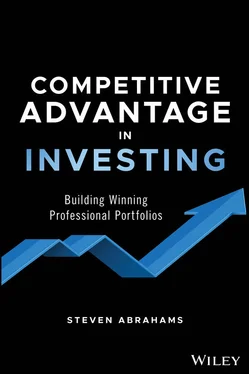Finally, the market over time has run through a natural experiment that puts Frazzini and Pedersen's thinking to the test, thanks to the Federal Reserve. The Securities Exchange Act of 1934 gives the Fed the right under Regulation T to set a minimum amount of equity, or margin, and, consequently, the maximum amount of debt an individual can use to buy common stock on credit on a US exchange. From October 1934 to January 1974, the Fed changed the minimum margin requirement 22 times, allowing it to range from 40% of the market value of stock purchased to 100%. Each change in required margin shifted the limits on leverage across the entire US stock market. Each change put Frazzini and Pedersen to the test.
In Espoo, Finland, on the Baltic Sea, Petri Jylhä, a professor at the Aalto University School of Business, noticed the Fed's natural experiment as a way to test Frazzini and Pedersen. As the Fed's margin requirement moved higher, Jylhä recognized, the capital market line should get progressively flatter. If that happened, it would give further support to the case for betting-against-beta.
Jylhä started by showing that the Fed typically changed margin requirements in response to a surge or drop in credit, raising margin requirements after a steady rise in the amount of stock bought on credit and lowering margin requirements after a steady drop (Jylhä, 2018). After the Fed raised margin requirements, the amount of credit would fall over the next year by an average of 15%. And after the Fed lowered margin requirements, credit would rise over the next year by an average of 17%. Jylhä also found the Fed raised the margin after a steady run-up in stock prices and lowered the margin after a steady drop. Congress had given the Fed responsibility for managing leverage available to investors and smoothing the ups and downs in stocks, and the Fed was doing its job.
Jylhä then went on to see if a change in margin also changed important elements of the market or the economy, elements that might also change the performance of low or high beta stocks. Changes in margin had no impact on market returns, trading activity, inflation, the money supply, or industrial production. That lined up nicely with comments from Fed chairs and press reports about the time of policy changes that the market and economy took the changes in stride.
Finally, Jylhä turned to a direct test of Frazzini and Pedersen. Betting-against-beta would predict that rising margin would steadily raise the returns on low beta assets and lower the returns on high beta assets, flattening the capital markets line. Jylhä found a striking result. At high levels of required margin, expected returns from low to high beta not only ran flat, they actually fell. When the ability to borrow vanished, expected returns in high beta stocks fell well below the likely outcomes in low beta stocks. As Frazzini and Pedersen had predicted, CAPM had unraveled.
Limits on More Than Leverage
The line of thinking first kindled by Fisher Black and fueled by Andrea Frazzini and Lasse Pedersen leads directly to considering all limits that shape investor behavior and asset value. Differences in access to leverage, for instance, create incentive for some investors to hold assets that inefficiently deliver risk and return. Those constrained investors reach for high beta stocks, and pricing of high beta stocks becomes dominated by inefficient capital flows. Limited leverage is not the only investor constraint, however. The cost of funds, the ability to hedge or offset risk, the quality of information, tax law, accounting rules, and legal and political constraints have heavy influence on individual and institutional portfolios. To the extent that constraints divide investors and their capital into groups and groups dominate different parts of the investment market, constraints shape asset value. Asset value changes systematically not just with the broad influences captured by market beta but also with the changing constraints on groups of investors.
In a market with constrained investors, each investor has to find a portfolio that efficiently considers the risk and return of the broad market, the current and future constraints the investor faces, and the current and future constraints of other investors. These all are risks that investors cannot diversify away and that require compensation. Robert Merton (1973a) long ago sketched the outlines of a market where investors considered not just the market basket of investments but also their ability to actually use the returns from their investment portfolios or reinvest those returns. Managing an efficient portfolio requires looking out into possible future investment opportunities and the constraints that shape both the investor and competing portfolios. That is the direction where theory goes next.
1 1The return on a betting-against-beta or BAB portfolio is where .
Конец ознакомительного фрагмента.
Текст предоставлен ООО «ЛитРес».
Прочитайте эту книгу целиком, на ЛитРес.
Безопасно оплатить книгу можно банковской картой Visa, MasterCard, Maestro, со счета мобильного телефона, с платежного терминала, в салоне МТС или Связной, через PayPal, WebMoney, Яндекс.Деньги, QIWI Кошелек, бонусными картами или другим удобным Вам способом.












